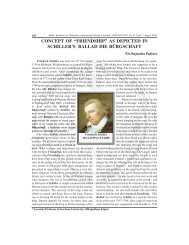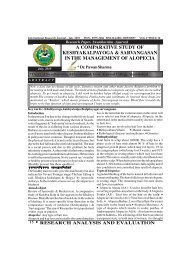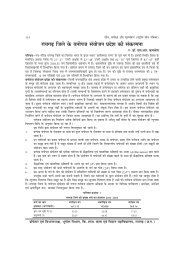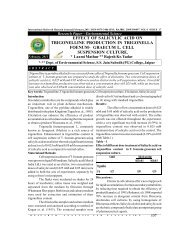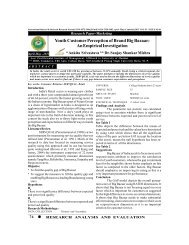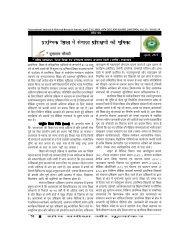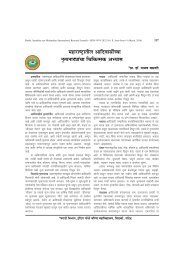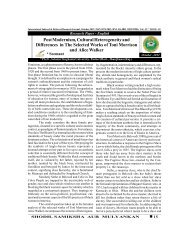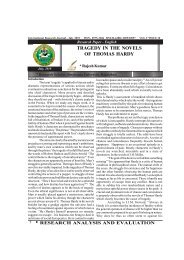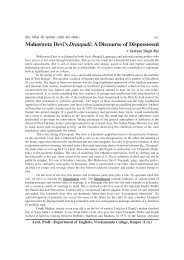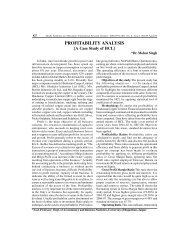Socio-economic Problems of Tribal People on Toranmal Plateau In ...
Socio-economic Problems of Tribal People on Toranmal Plateau In ...
Socio-economic Problems of Tribal People on Toranmal Plateau In ...
You also want an ePaper? Increase the reach of your titles
YUMPU automatically turns print PDFs into web optimized ePapers that Google loves.
<strong>In</strong>ternati<strong>on</strong>al Referred Research Journal,August, 2011. ISSN- 0974-2832, RNI-RAJBIL 2009/29954;VoL.III *ISSUE-31<br />
T able N o 1 M igratio n <str<strong>on</strong>g>of</str<strong>on</strong>g> popu lati<strong>on</strong> from T oranm al p late au as per sam p le adopted d uring 2008 -2009<br />
N a m e <str<strong>on</strong>g>of</str<strong>on</strong>g> th e B it N o o f T o tal<br />
N o o f N a m e o f T o tal<br />
T h e n o o f % o f<br />
villa g e/ Po p u la ti<strong>on</strong> fa m ilies sa m p le Po p u la ti<strong>on</strong> p eop le<br />
m ig ra ti<strong>on</strong> to<br />
Pa d a in A ccessed<br />
su rv ey in 2 00 8 -0 9 m ig ra tin g th e to tal<br />
B it<br />
20 01<br />
villa g e<br />
seas <strong>on</strong> a lly p op u la ti<strong>on</strong><br />
Jh ap i 15 36 5 9 77 2 - - - -<br />
Shind hidiger 12 32 5 1 53 2 - - - -<br />
T oran m a l E ast 04 69 6 18 6 02 43 1 24 5 56 .8 4<br />
T oran m a l W est 08 20 6 0 43 6 02 13 9 0 77 6 55 .8 2<br />
K alap ani 10 14 8 5 30 6 - - - -<br />
K hadki 08 15 8 9 42 1 01 35 0 29 5 84 .2 8<br />
M oda lg a <strong>on</strong> 10 33 3 0 71 4 02 94 5 48 0 50 .7 9<br />
Jayap an i 04 35 5 78 - - - -<br />
K otb an dh a ni 06 17 3 8 26 4 02 90 8 46 5 51 .2 1<br />
T otal 77 18 7 23 37 0 9 09 40 2 4 22 6 1 56 .1 8<br />
C) Community co-ordinati<strong>on</strong> problem:<br />
The tribal people <str<strong>on</strong>g>of</str<strong>on</strong>g> this area Pawara and Bhilla<br />
communities have different ancestral history. Bhillas<br />
are aboriginal and Pawara communities are migrated<br />
from other states. The inherent occupati<strong>on</strong> <str<strong>on</strong>g>of</str<strong>on</strong>g> Bhilla was<br />
hunting and shifting cultivati<strong>on</strong>. The Pawara Migrated<br />
here for teak wood cutting. Therefore both the communities<br />
are also occupati<strong>on</strong>ally different. Hence they are<br />
facing the community co-ordinati<strong>on</strong> problem since past.<br />
D) Health and malnutriti<strong>on</strong> Problem:-<br />
The agriculture is traditi<strong>on</strong>al and comparatively<br />
less productive in this area. It is facing several<br />
problems like, soil erosi<strong>on</strong>, soil degradati<strong>on</strong> climatic<br />
extremities and hazards. Therefore agriculture products<br />
are very poor and unsustainable to the tribal populati<strong>on</strong>.<br />
Even the basic needs <str<strong>on</strong>g>of</str<strong>on</strong>g> the tribal are not fulfilled<br />
by their <str<strong>on</strong>g>ec<strong>on</strong>omic</str<strong>on</strong>g> activities.<br />
E) Seas<strong>on</strong>al migrati<strong>on</strong><br />
The main subsistence in this area is agriculture,<br />
which depends up<strong>on</strong> m<strong>on</strong>so<strong>on</strong>. Nearly 137 families<br />
have very small land holding whereas 154 families<br />
depend up<strong>on</strong> trespass land <str<strong>on</strong>g>of</str<strong>on</strong>g> forest. The trespass lands<br />
are owned by forest department. Therefore forest department<br />
creates troubles to the peasants. Hence such<br />
lands are low yielding in agricultural products. Moreover<br />
yields <strong>on</strong> trespass land are less than regular lands.<br />
Therefore agricultural products are not sufficient to<br />
survive or sustain the populati<strong>on</strong> in this area.<br />
See Table No 1 09 Villages have been selected for<br />
seas<strong>on</strong>al migrati<strong>on</strong> survey. Out <str<strong>on</strong>g>of</str<strong>on</strong>g> the total 3709 families,<br />
2261 families from villages are migrated every year<br />
after m<strong>on</strong>so<strong>on</strong> seas<strong>on</strong> in search <str<strong>on</strong>g>of</str<strong>on</strong>g> work. Deteriorati<strong>on</strong><br />
<str<strong>on</strong>g>of</str<strong>on</strong>g> forest and degradati<strong>on</strong> <str<strong>on</strong>g>of</str<strong>on</strong>g> soil are the major causes.<br />
Landless tribals are generally mobile in search <str<strong>on</strong>g>of</str<strong>on</strong>g> jobs<br />
like brick work, sugar cane cutting, labours in c<strong>on</strong>structi<strong>on</strong><br />
site, farm keeper, watchman etc. Their income is too<br />
poor to manage a <strong>on</strong>etime food in day. This is the main<br />
cause behind the malnutriti<strong>on</strong>.<br />
2) Lack <str<strong>on</strong>g>of</str<strong>on</strong>g> health facilities:-<br />
The public health centers are available in very<br />
few places like Tornmal and Ranipur due to the remote<br />
mountainous topography and inaccessibility. But doctors<br />
are not available in such centers. C<strong>on</strong>sequently,<br />
tribal people rely <strong>on</strong> traditi<strong>on</strong>al methods <str<strong>on</strong>g>of</str<strong>on</strong>g> treatments.<br />
<strong>In</strong>fants are becomes weak as they kept away from the<br />
breast feed for several days.<br />
4 Suggesti<strong>on</strong> and remedial measures to mitigate the<br />
problem <str<strong>on</strong>g>of</str<strong>on</strong>g> malnutriti<strong>on</strong>:-<br />
1) Every child birth and death should be registered and<br />
should be checked immediately after his birth by a registered<br />
medical pediatrist doctor. Further each child<br />
should be checked at least after every 2 to 3 m<strong>on</strong>ths by<br />
the doctor.<br />
2) Food for the mother and baby should be provided at<br />
a free cost by the government when they need.<br />
3) The maternity progress <str<strong>on</strong>g>of</str<strong>on</strong>g> the pregnant woman should<br />
be checked after 2 to 3 m<strong>on</strong>ths by a medical practiti<strong>on</strong>er.<br />
R E F E R E N C E<br />
Bhamare S.M. and Suryawanshi U.P (2008)-"Textural and chemical characteristics <str<strong>on</strong>g>of</str<strong>on</strong>g> soils <str<strong>on</strong>g>of</str<strong>on</strong>g> the <strong>Toranmal</strong> plateau in Satpura<br />
mountain <str<strong>on</strong>g>of</str<strong>on</strong>g> Nandurbar District <str<strong>on</strong>g>of</str<strong>on</strong>g> Maharastra."-paper presented at the <strong>In</strong>ternati<strong>on</strong>al C<strong>on</strong>ference Organized <str<strong>on</strong>g>of</str<strong>on</strong>g> Barkttula<br />
University, Bhopal. Bhamare S.M and U.P. Suryawanshi (2007) "Impact <str<strong>on</strong>g>of</str<strong>on</strong>g> Relief and slope <strong>on</strong> land use <str<strong>on</strong>g>of</str<strong>on</strong>g> <strong>Toranmal</strong> plateau"<br />
Research Link - 44 Vol (9) Nov. Page No. 41-44 Choudhari Buddhadeb (1982) <str<strong>on</strong>g>Tribal</str<strong>on</strong>g> Development in <strong>In</strong>dia - problem and prospects.<br />
<strong>In</strong>ter <strong>In</strong>dia Publicati<strong>on</strong>s, New Delhi. Pagare M.S.- Pawara Lokgitatil loksanskruti Patil P.G. and V.U. Borse- (2000). <str<strong>on</strong>g>Socio</str<strong>on</strong>g>-<br />
Ec<strong>on</strong>omic status <str<strong>on</strong>g>of</str<strong>on</strong>g> Kokani tribe <str<strong>on</strong>g>of</str<strong>on</strong>g> Dhule district, <str<strong>on</strong>g>Tribal</str<strong>on</strong>g> research and training institute, Pune. Vol XXII No.2 March.<br />
43<br />
S H O D H , S A M I K S H A A U R M U L Y A N K A N



